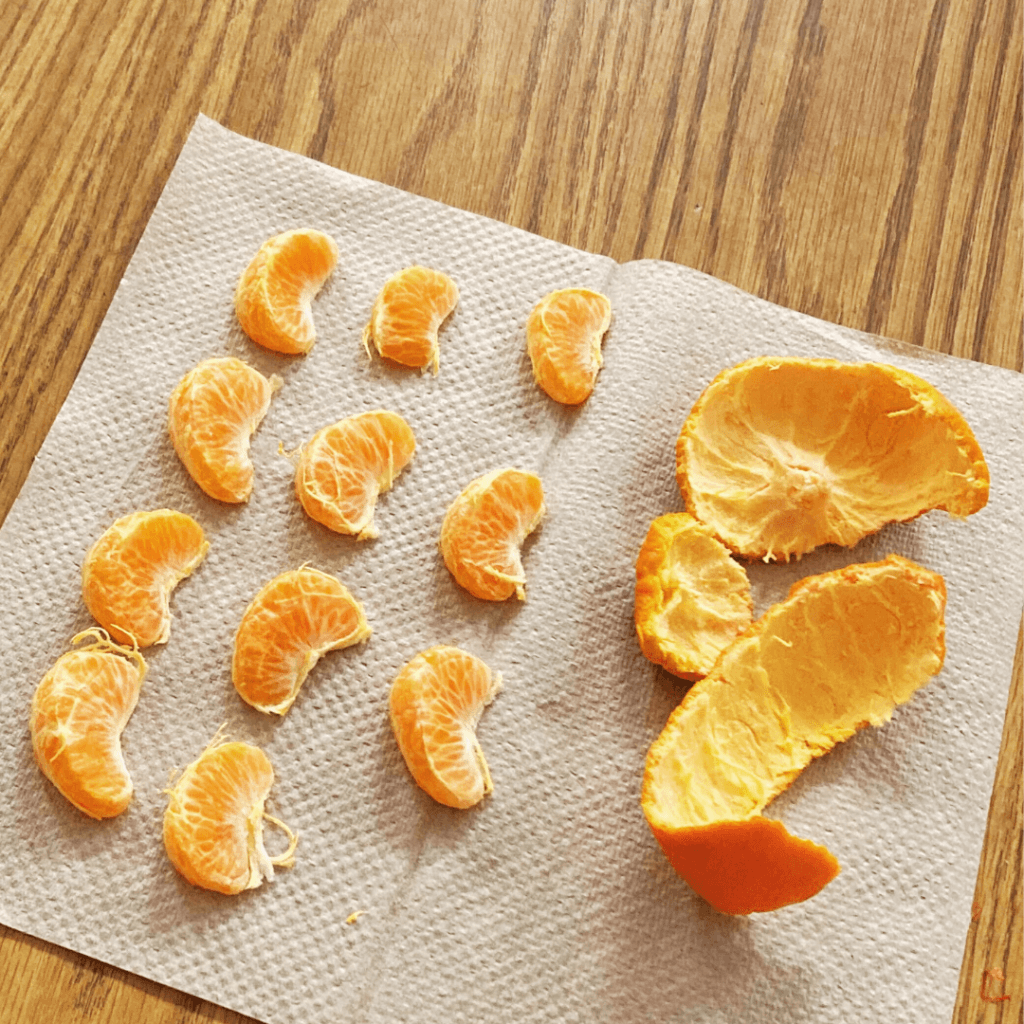Mindful eating is the practice of paying attention to the present moment, intentionally and without judgment, with food. Join us on a juicy journey as we explore mindful eating with clementines.
Why Mindful Eating?
Practicing mindful eating isn’t just about savoring the flavors of our food; it’s an experience that can nurture our overall well-being. In a world where distractions abound, taking the time to engage in mindful eating allows us to reconnect with the present moment. By immersing ourselves in the sensory experience of our food, we cultivate a heightened awareness of taste, texture, and aroma. One mindful bite can offer us a glimpse into our connection with the natural environment which grew this food, as well as a connection to the diversity of people who have brought it to our doorstep. This intentional exercise also allows us to slow down and insert a pause into a daily routine that can often be rushed: snack time or meal time.
Classroom Activity:
Mindful Eating with Clementines
Taking a moment to get curious about your food can be a fun and yummy experience. Join us on a juicy journey as we explore mindful eating with clementines. In this lesson, we’re using clementine oranges; you could also have students use snacks they’ve brought from home. My public school frequently provides a free morning taste of local produce, which makes it easy and cost effective to regularly incorporate mindful eating into our curriculum.
We can be mindful of anything we do when we bring our full attention to it. Today, we’re going to practice eating mindfully. Do you ever notice that sometimes you eat without really paying attention to what you are doing? Let’s see what it’s like when we eat mindfully.
Before we peel and eat our oranges, take a moment to notice everything you can. Consider investigating them like a scientist would (perhaps connect to any science lesson you may have done in which students have used their science exploration skills):
- What do you notice with your eyes?
- With your nose?
- With your fingers?

Invite students to share what they notice with their senses: smells, texture, colors, shapes. Encourage them to notice little details they may usually miss. “Is the orange the color orange everywhere? What other colors do you see?” You can also have them record or share predictions with each other about how many segments there might be or what the taste might be like, scaffolding their language with specific language.
Now let’s begin to peel our oranges. How is the inside different from the outside? Let’s peel our oranges slowly, noticing all the movements we make with our hands and fingers to do it.
- What does the peel feel like? What color is the peel on the inside? What color are the slices inside?
- What smells do you notice as you peel the orange? Do you notice if you’re getting hungry?
- Do you notice if you really want to just eat it already?
Now we’re going to eat, but we are going to eat very slowly. You might take a whole minute to finish just one slice. Pause and perhaps take a breath together before beginning to eat. You can even say, “Ready…set…slow.”

After about a minute, ask “What does it taste like?” and allow for a variety of different responses.
Encourage students to share their descriptions of the taste: sweet, tangy, sugary, sour, etc.
Let’s end with a moment thinking about all that had to happen for us to have these oranges. I went to the store to buy them; store workers put them on the shelves and kept them fresh for us; truck drivers drove them to the store; farmers had to grow and pick them; and the sun had to shine to give them nutrients.
You might want to extend this lesson to include researching location specific information about where the food was grown and the faces of the people who were involved in its production. For example, my students used this mindful eating lesson to discover that our clementines were grown in California, harvested by farmworkers, many of whom were of Latinx descent, and most likely driven by the Indian- American truck drivers who frequently transport goods across the border to our small town in Oregon.
Class Debrief
Give students as much time as you can to make sense of their experience. It’s the most important part of the mindful moment! You may want to begin with a whole class check-in with a thumbs up/thumbs down for how easy or challenging this activity was, as well as offer plenty of ways to allow for all students to share in some way. This could be through turning and talking with a partner or having a class discussion, for instance:
- What was it like to eat this way? Was it different from how you usually eat?
- What would it be like if we ate this way all the time?
- When do you think you might like to try mindful eating again?
After I did this activity with my 4th graders, I gave students the option to write in their journals or draw about the experience including labeling all the details that we noticed while eating mindfully.

Close with Relevance
Mindful eating isn’t just for students! This practice invites all of us to slow down, savor each bite, and tune into the subtle cues our senses provide. When children see how we also experience this practice in our lives, they are more likely to understand how it is relevant to theirs. It is powerful to bring this lesson home by talking about when you like to engage in mindful eating and what you notice when you do.
My favorite story is usually about taking the time to stop and sip my coffee mindfully, which always feels like a warm hug and interrupts my busy mind with gratitude and compassion for myself and all those who were able to bring this cup of goodness to me.

Educators, Explore Mindfulness in our 101 Course
In 101: Mindfulness Foundations, learn practices that can resource you during the school day and daily life, with trauma-sensitive approaches for navigating emotons, working with thoughts and biases, and cultivating compassion and joy. Educators earn credits.
Bring Mindfulness to Your Classroom
In 201: Mindfulness in the Classroom, learn trauma-sensitive strategies to nurture social and emotional well-being in your classroom. Access the Mindful Schools K-12 Curriculum and Teaching Kit. Educators earn credits.




